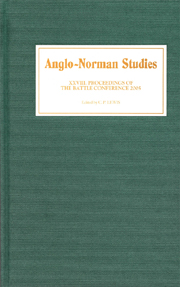Book contents
- Frontmatter
- Contents
- LIST OF ILLUSTRATIONS, MAPS, AND TABLES
- EDITOR'S PREFACE
- ABBREVIATIONS
- Inside the Anglo-Norman Family: Love, Marriage, and the Family (R. Allen Brown Memorial Lecture)
- Land Tenure and Royal Patronage in the Early English Kingdom: A Model and a Case Study
- The Homilies of a Pragmatic Archbishop's Handbook in Context: Cotton Tiberius A. iii
- Robert de Vaux and Roger de Stuteville, Sheriffs of Cumberland and Northumberland, 1170–1185
- The Common Steeple? Church, Liturgy, and Settlement in Early Medieval Lincolnshire
- The Question of Masculinity in William of Malmesbury's Presentation of Wulfstan of Worcester
- Share and Share Alike? Bishops and their Cathedral Chapters: The Domesday Evidence
- Dunstan and Monastic Reform: Tenth-Century Fact or Twelfth-Century Fiction?
- Domesday Now
Share and Share Alike? Bishops and their Cathedral Chapters: The Domesday Evidence
Published online by Cambridge University Press: 12 September 2012
- Frontmatter
- Contents
- LIST OF ILLUSTRATIONS, MAPS, AND TABLES
- EDITOR'S PREFACE
- ABBREVIATIONS
- Inside the Anglo-Norman Family: Love, Marriage, and the Family (R. Allen Brown Memorial Lecture)
- Land Tenure and Royal Patronage in the Early English Kingdom: A Model and a Case Study
- The Homilies of a Pragmatic Archbishop's Handbook in Context: Cotton Tiberius A. iii
- Robert de Vaux and Roger de Stuteville, Sheriffs of Cumberland and Northumberland, 1170–1185
- The Common Steeple? Church, Liturgy, and Settlement in Early Medieval Lincolnshire
- The Question of Masculinity in William of Malmesbury's Presentation of Wulfstan of Worcester
- Share and Share Alike? Bishops and their Cathedral Chapters: The Domesday Evidence
- Dunstan and Monastic Reform: Tenth-Century Fact or Twelfth-Century Fiction?
- Domesday Now
Summary
This paper looks at the tenurial relationship between bishops and their familiae in the aftermath of the Norman Conquest, and in particular at the evidence in Domesday Book for the organization of a separate endowment for the community. Although the evidence was considered by Professor Crosby in his major study of the mensa episcopalis, it seems worth while reconsidering it afresh and in isolation, in order to get a better sense of how far the division of endowments between bishops and their chapters had progressed by the time that Domesday Book provides the first opportunity to look systematically across the dioceses, barely a generation after the Norman Conquest. While reference is made to the archdioceses of Canterbury and York, the focus here is largely on the bishoprics. The last quarter of the eleventh century was a period of transition for both secular and monastic cathedral communities, not least because of the relocation of several sees and the building anew of every English cathedral within the first fifty years after the Conquest. It is argued that while some evidence of change can be found in Domesday, there was no great tenurial revolution as some form of separate endowment was already in place for most cathedral chapters before the Conquest.
Despite the impetus of Benedictine reform in the tenth century, of the fifteen dioceses extant in 1066 only three maintained monastic chapters (Canterbury, Winchester, and Worcester); the rest housed secular canons.
- Type
- Chapter
- Information
- Anglo-Norman Studies 28Proceedings of the Battle Conference 2005, pp. 138 - 152Publisher: Boydell & BrewerPrint publication year: 2006



